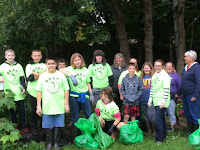Aleksandr Solzhenitsyn, the Nobel Prizing writing writer and Soviet dissident, spent 18 of his 20 years in exile in Cavendish, VT. With the publication of Between Two Millstones: Sketches of Exile, 1974-1977 now there is more than a glimpse of what life was like for him during this time.
"Between
Two Millstones" contains vivid descriptions
of Solzhenitsyn's journeys to various European countries and North American
locales, where he and his wife Natalia (“Alya”) searched for a location to
settle their young family. There are fascinating descriptions of one-on-one
meetings with prominent individuals, detailed accounts of public speeches such
as the 1978 Harvard University commencement, comments on his television
appearances, accounts of his struggles with unscrupulous publishers and agents
who mishandled the Western editions of his books, and the KGB disinformation
efforts to besmirch his name. There are also passages on Solzhenitsyn's family
and their property in Cavendish, Vermont, whose forested hillsides and harsh
winters evoked his Russian homeland, and where he could finally work undisturbed
on his ten-volume history of the Russian Revolution, The Red Wheel. Stories include the efforts made to assure a
proper education for the writer's three sons, their desire to return one day to
their home in Russia, and descriptions of his extraordinary wife, editor,
literary advisor, and director of the Russian Social Fund, Alya, who
successfully arranged, at great peril to herself and to her family, to smuggle
Solzhenitsyn's invaluable archive out of the Soviet Union. Notre Dame Press
For
Vermonters, Senator Patrick Leahy summed it up when he wrote, “Aleksandr
Solzhenitsyn took to Vermont and Vermonters took to him. I felt it a privilege
to have met with him in his new Vermont setting, and I know that our state’s
forested beauty reminded him of home. We are proud that he believed that his
homeland, and the world, could learn from the local self-government that is
embodied in Town Meeting Day in towns and hamlets across the Green Mountain
State.”
There were differing
ideas of how Solzhenitsyn lived in Cavendish- a self -imposed “gulag,” to a
lavish lifestyle in a “gated” compound. However, the truth was quite different.
The suddenness of our move caught
everyone’s attention: it is unacceptable for people of fame not to inform the
world of what they are doing, not to advertise their next move but to go ahead
and do what they want unannounced. Over a hundred press vehicles now converged
on the tiny town of Cavendish from Boston, from New York, quizzing the
townspeople to get information, journalists crowding in front of our gate,
scurrying along our fence—they even arranged for a helicopter to fly over our
property and take pictures. ....To make things worse, our light chain-link
fence had a single strand of barbed wire on top where the fence ran along the
side of the road, to hook the pants of snoopers trying to climb over. This
single strand of barbed wire the media now magnified into a “barbed-wire fence
surrounding the entire property,” and that it was if I were willing myself up
in a new prison, a “self-imposed gulag.” I did intend to sequester myself, not
in a prison but in a tranquil refuge, the kind necessary for creativity in this
mad, whirling world. But the press also picked up details from the locals about
us having a pond, setting off the legend about my “swimming pool,” which
immediately turned our supposed life within a prion into a “bourgeois
lifestyle” in which the Solzhenitsyn family now intended to indulge. Ah,
wretches, they were writing not about us but about themselves, revealing what
mattered to them. We have been expelled from our country, our hearts are
constricted, my wife’s eyes are never dry of tears, only work can save us—and
that is our so-called “bourgeois lifestyle.”
Between Two Millstones is available at Amazon in both hardcover and Kindle formats.







